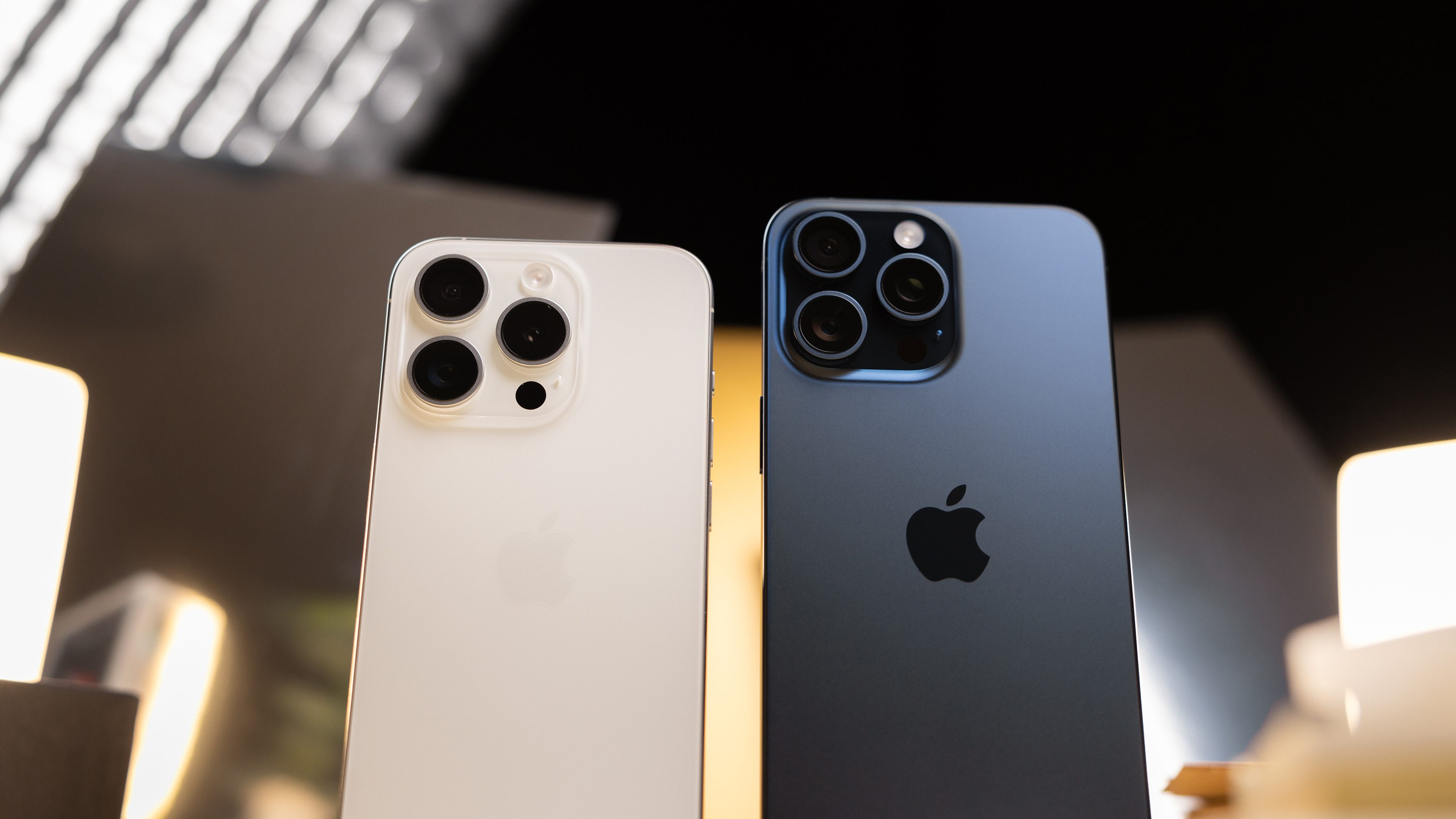
Is the iPhone 15 Pro Max worth it because of a better camera?
The short answer to this question is: No. You can find the detailed answer further down in this article. First of all, here are the basics: what’s the difference between the cameras in the iPhone 15 Pro and iPhone 15 Pro Max?
Both smartphones have the same ultra-wide angle camera and the same primary camera. That means the difference can only be seen when zoom is involved, and both iPhones have exactly one telephoto camera. The iPhone 15 Pro offers 3x zoom, while the iPhone 15 Pro Max has a 5x zoom. Here is a short overview:
| Zoom | ||
|---|---|---|
| Ultra-wide angle 0.5x | ||
| Main camera 1.0x | ||
| Telephoto zoom 3.0x | ||
| Telephoto zoom 5.0x | ||
| Offers |
With the Apple iPhone 15 Pro, you have three cameras that are relatively close to each other in terms of capability: the ultra-wide angle (0.5x), a main camera (1.0x), and a telephoto camera (3.0x). The iPhone 15 Pro Max, on the other hand, has a much larger gap between the main camera and the 5x telephoto camera. This means that you have a better image quality at “full zoom”, but the image quality drops significantly between the main and telephoto cameras since you still end up with a digitally enlarged photo taken by the main camera at 4x zoom for instance.
The following infographic visualizes this better. On the left, we begin with the ultra-wide angle. When zooming in, the effective resolution first drops before increasing, thanks to the 48 megapixels of the high-resolution sensor in the main camera. If we were to zoom in further, the resolution will drop again until both iPhones switch to the telephoto camera at 3x zoom (Pro) or 5x zoom (Pro Max).

The theory is simple: The higher the resolution, the better the image quality gets. Of course, it is not the resolution that plays a role, but also the effective sensor area that is available at the respective zoom. As you can see in the second diagram below, this behaves very similarly to the effective resolution in both iPhones.
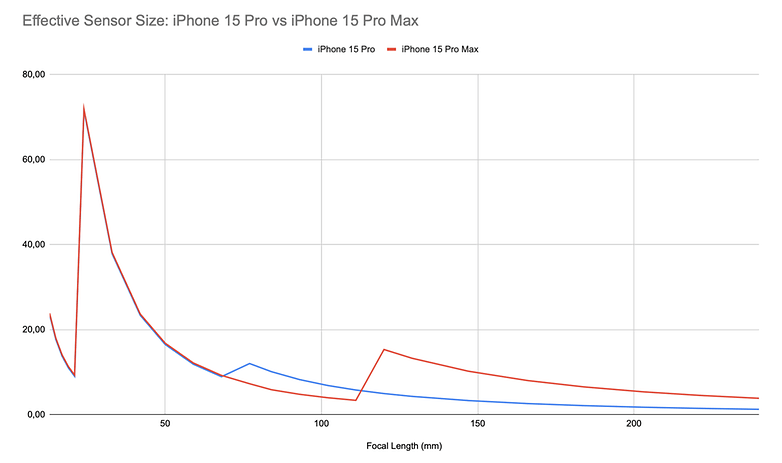
So much for the gray theory. But what does it actually look like in practice? Of course, we have already compared the two new Pro iPhones for you.
Image quality in reality: iPhone 15 Pro vs iPhone 15 Pro Max
As expected, there are no noticeable differences in the image quality of the ultra-wide angle and main cameras of the two Pro iPhones. The same camera modules are used here. However, as soon as we zoom in on a subject, the image quality of the two iPhones diverged noticeably, just like how it was predicted according to our theory.
Portrait with the iPhone 15 Pro and Pro Max at 3x zoom
When shooting a photo using the 3x setting, the iPhone 15 Pro does it much better. It is no wonder the iPhone 15 Pro Max doesn’t even offer this option in the camera app. If you want to achieve a setting apart from “1x”, “2x” and “5x”, then you will have to zoom via the two-finger gesture. The iPhone 15 Pro on the other hand offers “1x”, “2x” and “3x” in the camera app.
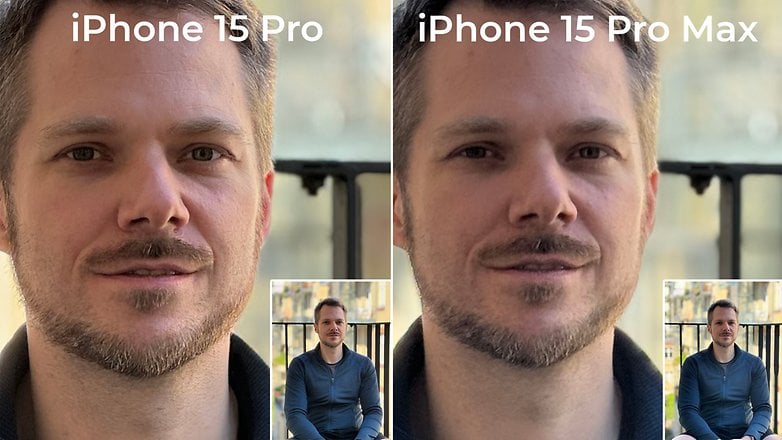
Portrait with iPhone 15 Pro and Pro Max with 5x zoom
The point here then, is reversed with the 5x zoom: The iPhone 15 Pro quickly loses quality here with its relatively small 12-megapixel sensor, while the iPhone 15 Pro Max has just switched to the 5x zoom sensor and thus delivers significantly more details. The difference is especially visible in the hair or eyes.
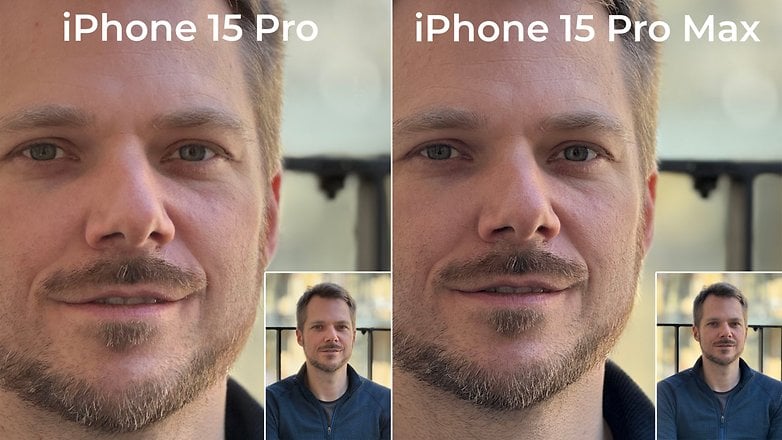
Fun fact: If you were to look closely, you might have noticed that the iPhone 15 Pro has a slightly different magnification at 5x zoom than the iPhone 15 Pro Max. And yes: When comparing our test photos, we almost lost our faith because of this, since we tried so hard to get usable shots. For the sake of completeness, here are the 35mm-equivalent focal lengths by zoom level in the app for the iPhone 15 Pro and iPhone 15 Pro Max. They are not identical after all.
| Zoom level | ||||||||||||||
|---|---|---|---|---|---|---|---|---|---|---|---|---|---|---|
| iPhone 15 Pro | ||||||||||||||
| iPhone 15 Pro Max |
As you can see, this does not make much sense, and strictly speaking, the 3x zoom of the iPhone 15 Pro is more like 3.2x zoom. However, this hardly matters in reality unless you want to strictly compare smartphones with each other like we do.
iPhone 15 Pro vs iPhone 15 Pro Max at 15x zoom
What does the difference in image quality look like at extremely high zoom? The answer is rather mind-blowing: The iPhone 15 Pro Max is not that far ahead as one might expect. See for yourself, here is the Berlin TV Tower taken at 15x zoom.
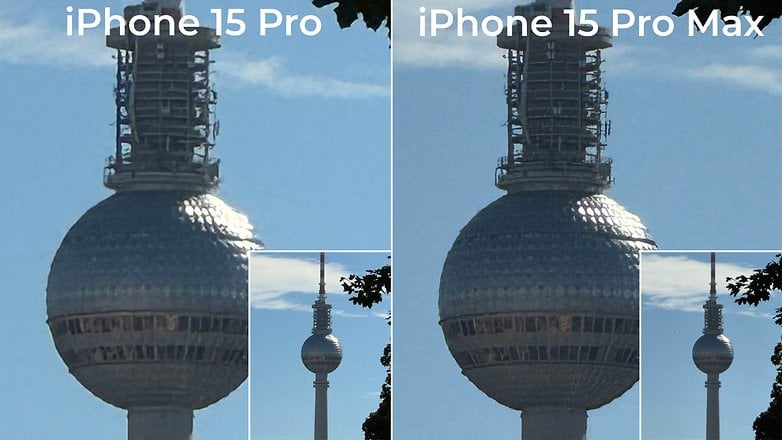
iPhone 15 Pro vs iPhone 15 Pro Max: picture quality in low-light conditions
Last but not least, we also pitted the iPhone 15 Pro and iPhone 15 Pro Max against each other in low-light conditions. For this, we photographed our standard test subject for smartphone cameras, using both iPhones and with 3x and 5x zoom. This direct comparison is striking: The 5x zoom photo of the iPhone 15 Pro is clearly worse in the Pro Max.
If you were to scroll up to the chart again with the available sensor areas according to focal length, you will also find the same reason here: The performance gap between the two smartphones is nowhere as stark as here. The difference in the 3x zoom photo, on the other hand, is much smaller, both in theory and in reality.
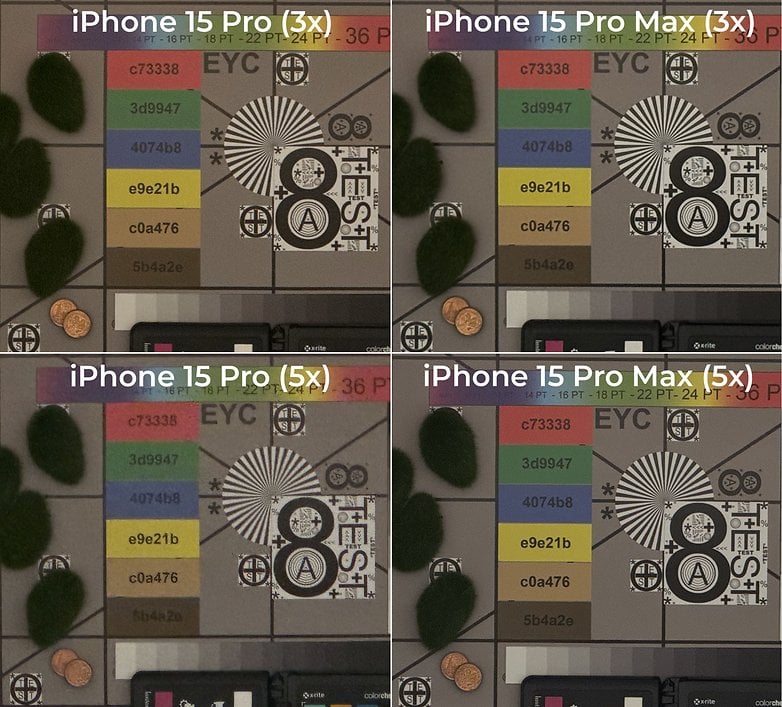
Conclusion: Do I buy the iPhone 15 Pro Max for its better camera?
After giving you the short answer, here is the conclusion of the long answer: No, you should not buy the iPhone 15 Pro Max (exclusively) for the better telephoto camera, especially if the form factor is rather too big for you or your budget is limited.
In fact, the opposite holds: The larger image quality gap in the focal length range takes away the spontaneity of taking pictures if you value image quality. When composing the image via its two-finger zoom, I have to bear in mind not only the subject, but also whether I will fall into an “image quality hole” with the respective magnification. The iPhone 15 Pro does not even have this gap.
Dear Apple engineers: For the iPhone 16 Pro, Max, and/or then maybe Ultra, I would like to see a quad-camera configuration with two telephoto lenses that offer a lot of zoom power and fill the gaps.






